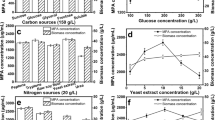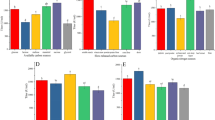Abstract
Echinocandin B (ECB) is a key precursor of antifungal agent Anidulafungin, which has demonstrated clinical efficacy in patients with invasive candidiasis. In this study, the effects of microparticle-enhanced cultivation and methyl oleate on echinocandin B fermentation titer were investigated. The results showed that the titer was significantly influenced by the morphological type of mycelium, and mycelium pellet was beneficial to improve the titer of this secondary metabolism. First, different carbon sources were chosen for the fermentation, and methyl oleate achieved the highest echinocandin B titer of 2133 ± 50 mg/L, which was two times higher than that of the mannitol. The study further investigated the metabolic process of the fermentation, and the results showed that L-threonine concentration inside the cell could reach 275 mg/L at 168 h with methyl oleate, about 2.5 times higher than that of the mannitol. Therefore, L-threonine may be a key precursor of echinocandin B. In the end, a new method of adding microparticles for improving the mycelial morphology was used, and the addition of talcum powder (20 g/L, diameter of 45 µm) could make the maximum titer of echinocandin B reach 3148 ± 100 mg/L.






Similar content being viewed by others
References
Fritz B, Jakob N, Nyfeler R, Hansjörg T, Walter V (1974) Echinocandin B, ein neuartiges polypeptid-antibioticum aus Aspergillus nidulans var. echinulatus: isolierung und bausteine. Helv Chem 57(8):2459–2477
Kurtz MB, Heath IB, Marrinan J, Dreikorn S, Onishi J, Douglas C (1994) Morphological effects of lipopeptides against Aspergillus fumigatus correlate with activities against (1,3)-β-D-glucan synthase. Antimicrob Agents Chemother 38:1480–1489
Morris MI, Villmann M (2006) Echinocandins in the management of invasive fungal infections, part 2. Am J Health-syst 63(18):1693–1703
Robbins N, Wright GD, Cowen LE (2016) Antifungal drugs: the current armamentarium and development of new agents. Microbiol Spectr 4(5):903–904
Denning DW (2002) Echinocandins: a new class of antifungal. J Antimicrob Chemother 49(6):889–891
Cappelletty D, Eiselstein-Mckitrick K (2007) The echinocandins. Pharmacother J Hum Pharmacol Durg Ther 27(3):369–388
Carter NJ, Keating GM (2009) Micafungin: a review of its use in the prophylaxis and treatment of invasive candida infections in pediatric patients. Pediatr Drugs 11(4):271–291
Groll AH, Tragiannidis A (2009) Recent advances in antifungal prevention and treatment. Semin Hematol 46(3):212–229
Zou SP, Zhong W, Xia CJ, Gu YN, Niu K, Zheng YG (2015) Mutagenesis breeding of high echinocandin B producing strain and further titer improvement with culture medium optimization. Bioprocess Biosyst Eng 38(10):1845–1854
Hu ZC, Peng LY, Zheng YG (2016) Enhancement of echinocandin B production by a UV- and microwave-induced mutant of Aspergillus nidulans with precursor and biotin supplying strategy. Appl Biochem Biotechnol 179(7):1213–1226
Antecka A, Bizukojc M, Ledakowicz S (2016) Modern morphological engineering techniques for improving productivity of filamentous fungi in submerged cultures. World J Microbiol Biotechnol 32(12):193–202
Lu F, Ping K, Wen L, Zhao W, Wang Z, Chu J (2015) Enhancing gluconic acid production by controlling the morphology of Aspergillus niger in submerged fermentation. Process Biochem 50(9):1342–1348
Hama S, Onodera K, Yoshida A, Noda H, Kondo A (2015) Improved production of phospholipase A1 by recombinant Aspergillus oryzae through immobilization to control the fungal morphology under nutrient-limited conditions. Biochem Eng J 96:1–6
Yang J, Jiao RH, Yao LY, Han WB, Lu YH, Tan RX (2016) Control of fungal morphology for improved production of a novel antimicrobial alkaloid by marine-derived fungus Curvularia sp. IFB-Z10 under submerged fermentation. Process Biochem 51(2):185–194
Barriosgonzalez J, Miranda RU (2010) Biotechnological production and applications of statins. Appl Microbiol Biotechnol 85(4):869–883
Bizukojc M, Ledakowicz S (2010) The morphological and physiological evolution of Aspergillus terreus mycelium in the submerged culture and its relation to the formation of secondary metabolites. World J Microbiol Biotechnol 26(1):41–54
Papagianni M (2004) Fungal morphology and metabolite production in submerged mycelial processes. Biotechnol Adv 22(3):189–259
Mahesh N, Balakumar S, Indumathi P, Ayyadurai A, Viverk R (2012) Production and optimization of Mevastatin using Penicillium citrinum NCIM 768. J Microb Biochem Technol 4(1):1–4
Rateb ME, Ebel R (2011) Secondary metabolites of fungi from marine habitats. Nat Prod Rep 28(2):290–344
Mcintyre M, Muller C, Dynesen J, Nielsen J (2001) Metabolic engineering of the morphology of Aspergillus metabolic engineering. Adv Biochem Eng Biotechnol 68(4):1827–1836
Driouch H, Sommer B, Wittmann C (2010) Morphology engineering of Aspergillus niger for improved enzyme production. Biotechnol Bioeng 105(6):1058–1068
Krull R, Wucherpfennig T, Esfandabadi ME, Walisko R, Melzer G, Hempel DC (2013) Characterization and control of fungal morphology for improved production performance in biotechnology. J Biotechnol 163(2):112–123
Zou SP, Liu M, Wang QL, Xiong Y, Niu K, Zheng YG (2015) Preparative separation of echinocandin B from Aspergillus nidulans broth using macroporous resin adsorption chromatography. J Chromatogr B 978:111–117
Hounoum BM, Blasco H, Emond P, Mavel S (2016) Liquid chromatography-high-resolution mass spectrometry-based cell metabolomics: experimental design, recommendations, and applications. TrAC Trends Anal Chem 75:118–128
Fu YQ, Li S, Chen Y, Xu Q, Huang H, Sheng XY (2010) Enhancement of fumaric acid production by Rhizopus oryzae using a two-stage dissolved oxygen control strategy. Appl Biochem Biotechnol 162(4):1031–1038
Emri T, Majoros L, Toth V, Pocsi I (2013) Echinocandins: production and applications. Appl Microbiol Biotechnol 97:3267–3284
Cacho RA, Jiang W, Chooi YH, Walsh CT, Tang Y (2012) Identification and characterization of the echinocandin B biosynthetic gene cluster from Emericella rugulosa NRRL 11440. J Am Chem Soc 134:16781–16790
Chen L, Liu X, An Z, Yue Q, Zhang X, Xiang M (2013) Genomics-driven discovery of pneumocandin biosynthetic gene cluster in the fungus Glarea lozoyensis. BMC Genom 14(1):339–357
Mouslim J, David L, Pétel G (1993) Effect of exogeneous methyl oleate on the time course of some parameters of Streptomyces hygroscopicus NRRL B-1865 culture. Appl Microbiol Biotechnol 39:585–588
Kaup BA, Ehrich K, Pescheck M, Schrader J (2008) Microparticle-enhanced cultivation of filamentous microorganisms: increased chloroperoxidase formation by Caldariomyces fumago as an example. Biotechnol Bioeng 99(3):491–498
Driouch H, Roth A, Dersch P, Wittmann C (2011) Filamentous fungi in good shape: microparticles for tailor-made fungal morphology and enhanced enzyme production. Bioeng Bugs 2(2):100–104
Niu K, Mao J, Zheng Y (2015) Effect of microparticle on fermentation process of filamentous microorganisms—a review. Acta Microbiol Sin 55(3):258–263
Acknowledgements
The authors gratefully acknowledge the financial supports of the National Key Research and Development Project of China (2018YFA0901400).
Author information
Authors and Affiliations
Corresponding author
Ethics declarations
Conflict of interest
The authors declare no financial or commercial conflict of interest.
Additional information
Publisher's Note
Springer Nature remains neutral with regard to jurisdictional claims in published maps and institutional affiliations.
Rights and permissions
About this article
Cite this article
Niu, K., Wu, XP., Hu, XL. et al. Effects of methyl oleate and microparticle-enhanced cultivation on echinocandin B fermentation titer. Bioprocess Biosyst Eng 43, 2009–2015 (2020). https://doi.org/10.1007/s00449-020-02389-3
Received:
Accepted:
Published:
Issue Date:
DOI: https://doi.org/10.1007/s00449-020-02389-3




